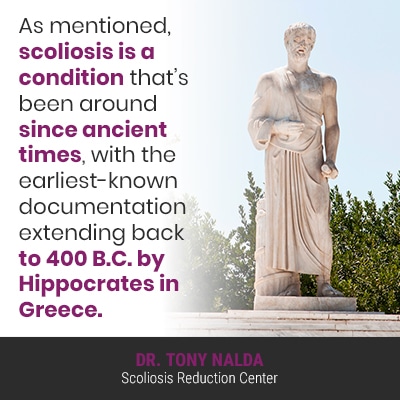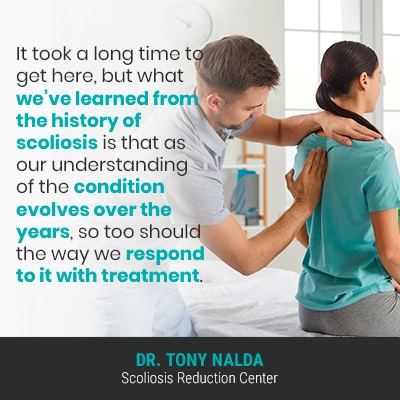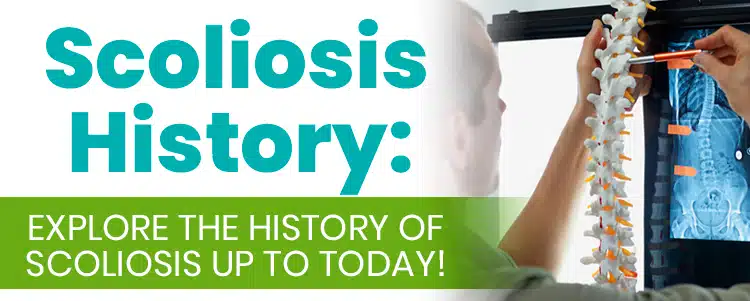Scoliosis has been around since ancient times when patients underwent some pretty extreme forms of treatment. The way scoliosis patients have had their conditions treated in the past includes being tied to sticks, pulled, pushed, stretched, and so on; luckily, our understanding of scoliosis and how it responds to treatment has evolved over the years.
Scoliosis is an ancient spinal condition the Greeks thought of as a deformity. The way scoliosis is viewed, represented, and treated has evolved over the years from a traditional surgical response to a modern conservative treatment approach with proven results.
Scoliosis history involves a shift in how the condition is responded to in terms of treatment, but let’s first define the condition and the parameters that have to be met in order to reach a scoliosis diagnosis.
4 Key Takeaways
- Evolution of Scoliosis Treatment: Scoliosis treatment has evolved significantly from ancient methods to modern conservative approaches. This evolution reflects a growing understanding of the condition’s complexity and the development of more effective, less invasive treatment options.
- Importance of Early Diagnosis and Proactive Treatment: Early diagnosis and proactive treatment have proven crucial in managing scoliosis effectively. Modern treatments aim for correction rather than mere containment, focusing on improving the condition structurally and functionally.
- Modern Bracing Technology: The development of corrective bracing, such as the ScoliBrace, marks a significant advancement in scoliosis treatment. Unlike traditional bracing, modern braces are designed to treat scoliosis as a three-dimensional condition, offering customized support that promotes correction.
- Comprehensive, Multidisciplinary Approach: A contemporary approach to treating scoliosis involves a multidisciplinary strategy that combines chiropractic care, specialized exercises, and corrective bracing. This comprehensive approach addresses scoliosis on multiple levels, aiming for long-term sustainable results.
Understanding Scoliosis
Scoliosis is a structural spinal condition that involves the development of an unnatural sideways spinal curve, with rotation and a minimum Cobb angle of 10 degrees.
The rotational component is what makes scoliosis a 3-dimensional condition as the spine doesn’t just bend unnaturally to the side but also twists from back to front, front to back.
There are three main spinal sections, and scoliosis can develop in any of them, although the thoracic spine is the most common location: cervical (neck), thoracic (middle/upper back), and lumbar (lower back).
A patient’s Cobb angle is a measurement taken during an X-ray that tells me how far out of alignment a scoliotic spine is and places conditions on a severity scale:
- Mild scoliosis: Cobb angle measurement of between 10 and 25 degrees
- Moderate scoliosis: Cobb angle measurement of between 25 and 40 degrees
- Severe scoliosis: Cobb angle measurement of 40+ degrees
- Very-severe scoliosis: Cobb angle measurement of 80+ degrees
The higher the Cobb angle, the more severe the condition, the more noticeable symptoms are likely to be, and the more complex it is to treat.
In scoliosis history, the advent of the Cobb angle is key as it became known as the orthopedic gold standard in the assessment of scoliosis; the Cobb angle method was invented in 1948 by Dr. John Cobb.

In addition, as a progressive condition, where scoliosis is at the time of diagnosis is not indicative of where it will stay; mild scoliosis can easily progress to moderate, severe, or very severe if left untreated or not treated proactively.
So how a condition is responded to, in terms of treatment, can have far-reaching consequences. Different treatment approaches respond differently, reflecting their different end goals: either stopping progression or achieving corrective results.
I’d also like to explain that there are different condition types, with their own causative sources and treatment needs, but the most prevalent type of scoliosis is idiopathic, meaning we don’t fully understand why it initially develops, and this is the form we’ll focus on for our current purposes; the most prevalent type of idiopathic scoliosis is adolescent idiopathic scoliosis, diagnosed between the ages of 10 and 18.
So in order to reach a diagnosis of scoliosis, an unnatural sideways spinal curve, with rotation and a Cobb angle of 10+ degrees, has to be detected.
Now that we have defined the condition and the parameters that have to be met to be considered true scoliosis, let’s travel back to ancient times when the condition was first discovered and named.
As mentioned, scoliosis is a condition that’s been around since ancient times, with the earliest-known documentation extending back to 400 B.C. by Hippocrates in Greece.
The term scoliosis is Greek for crooked and was coined by Galen in approximately 200 A.D.
Early thought about scoliosis viewed it as a deformity that needed to be fixed, and bracing was one of the first attempts to straighten a crooked scoliotic spine.
Scoliosis Bracing History
While scoliosis bracing is still used in treatment, not all braces are created equal, and fortunately, scoliosis braces have come a long way since the first bracing attempts in 650 A.D. that involved tying patients to wooden sticks.
From tying patients to sticks, the next step was the design of an actual brace; the first-known scoliosis brace was metal and was created in France in 1575.
Between 1950 and 2000, a variety of braces were designed and developed, the most commonly used being the Milwaukee and the Boston brace.
Bracing is an important part of scoliosis history because it not only represents the first attempts to treat the condition but also because it was the precursor to a traditional surgical response to scoliosis, which for many years was the dominant treatment option for patients.
Traditional Scoliosis Bracing
The theory behind traditional bracing is not that it will correct a scoliosis, but that it will prevent it from getting worse. Bracing does this by squeezing the spine unnaturally to hold it in a straighter position. Bracing has been described as a type of external spinal fusion, which we’ll explore more later.
The issue with traditional bracing is that it’s associated with a number of shortfalls, the main one being that its efficacy is limited because it only addresses scoliosis as a 2-dimensional condition, ignoring its rotational component.
The most popular traditional scoliosis brace continues to be the Boston, which was designed in the ‘70s, and its design has changed little, despite what we’ve learned about the condition and bracing efficacy over the years.
Via a 3-point pressure system, the spine is squeezed into a straighter position, but again, this doesn’t account for the rotation of the spine, and over time, the Boston has been known to weaken the spine, causing additional problems.
In addition, the Boston brace is mass-produced, so it isn’t customized. As you can recall from the wide range of Cobb angle measurements, scoliosis is a highly-variable condition, not to mention the many different body types the brace would have to suit.
In order for braces to be effective, they also have to be worn exactly as prescribed, and as traditional bracing is mass-produced, bulky, and cumbersome, and considering that teenagers are the most common age group to be diagnosed with scoliosis, compliance could be and has been a challenging issue.
Modern bracing adjusted its design based on the evident issues with traditional bracing, and instead of merely wanting to stop scoliosis from getting worse, corrective bracing wanted to help actually correct it: two very different things.
Modern Corrective Scoliosis Bracing
Modern corrective scoliosis bracing is driven by a different end goal and design and addresses many of the shortcomings associated with traditional bracing:
- Treats the condition as 3-dimensional
- Each brace is designed using state-of-the-art scanning technology for a customized fit = better compliance
- Works by pushing the spine into a corrective position, rather than squeezing it and weakening it
- It has the end goal of correcting scoliosis, not just stopping it from getting worse
The modern ultra-corrective ScoliBrace was released in 2012 and represents a new era for scoliosis bracing; it also represents the culmination of what we’ve learned about the condition, and bracing efficacy, over the years.
While those on the path of traditional treatment are likely to still be prescribed the Boston for full-time wear, modern conservative scoliosis treatment favors the corrective potential of the ScoliBrace.
In the context of scoliosis, a correction, or corrective results, means reducing the unnatural spinal curve on a structural level, increasing core strength, so the spine is optimally supported, and rehabilitating the spine for further stabilization and long-term sustainable results.
Scoliosis might not be curable, but it is highly treatable, especially if responded to with proactive treatment.
Now, in 2022, the Boston is still the most commonly-used traditional scoliosis brace, while the ScoliBrace is the top choice for augmenting corrective results through conservative treatment.
Scoliosis Surgery History
French surgeon, Jules Rene Guerin, was the first to attempt a surgical response to scoliosis in 1865; he did so by cutting the tendons and ligaments of the spine in an attempt to reduce postural deviation and straighten the spine.
Not surprisingly, these first surgical attempts were unsuccessful.
1895 saw the invention of the X-ray, making it possible to actually see the spine and how scoliosis affected it on every level for the first time. This led to new efforts and attempts to understand and treat the condition.
The 1950s saw Paul Harrington performing an early level of scoliosis surgery by attaching a single metal rod to the top and bottom of a scoliotic curve, and while it wasn’t successful in terms of reducing the curve, it was successful at slowing progression in adolescents.
French surgeons, Cotrel and Dubousset, took Harrington’s surgery further in the 1980s by introducing the double rod and pedicle screw hardware to hold the spine in a straighter position: hardware still currently used in scoliosis surgery.
Surgical attempts were also made to modulate spinal growth in patients who had not yet reached skeletal maturity by attaching vertebral body staples and tethers in 2009.
Currently, spinal fusion surgery is still a treatment option for patients, and while there are different types of spinal fusion, the procedure commonly involves fusing the most-tilted vertebrae of the curve, at its apex, into one solid bone.
The theory is that by fusing the vertebrae together, they can no longer move (progress), but eliminating movement in the area also means increasing spinal rigidity and decreasing range of motion: a surgical result many patients are disappointed with as it impacts quality of life.
For those undergoing traditional scoliosis treatment, they are likely to be funneled towards surgery because traditional treatment doesn’t have a strategy for treating scoliosis while mild, so it watches and waits to respond until the condition is severe enough to treat with surgery: no proactive preventative measures are made.
The reality is that most cases of scoliosis can be treated non-surgically, and modern scoliosis treatment includes a conservative treatment approach that values integrating multiple treatment disciplines for the best results, and believes in proactive treatment that prevents progression, rather than waiting for it to happen and then responding with invasive surgery.
Non-Surgical Scoliosis Treatment History
Non-surgical scoliosis treatment involves integrating multiple forms of treatment and monitoring to see how they affect the spine and complement one another.
As we learned more about the condition, and methods were developed to track progression and monitor how the spine is responding to treatment, it led to a shift in how scoliosis was responded to: strategies on how to impact it without surgery, how the condition could be treated without the potential complications and side effects of spinal fusion were developed.
Efforts were made to achieve corrective results through less-invasive non-surgical treatment that didn’t end up costing the spine in terms of its overall health and function, and as the success rates of non-surgical scoliosis treatment increased, the more medical professionals, and patients, were motivated to learn more.
In 1921, Katharina Schroth, a scoliosis patient herself from Dresden, Germany, who had been treated with bracing, decided to develop an exercise-based approach to treating scoliosis: the Schroth Method.
The time of exploring the place of exercise in the treatment of scoliosis was important because as we now know, it’s not just the spine that’s in charge of maintaining its natural curves and alignment, but also its surrounding muscles, so increasing core strength can help support the spine.
Exercise can also help counteract muscle imbalance that can develop due to the condition’s uneven forces, and this can help with pain management.
The early 2000s saw the first auto response re-training ideas and rehabilitation programs, as the role of rehabilitation in further stabilizing the spine for long-term sustainable treatment results was becoming explored.
Dr. Mark Morningstar, in 2013, spoke at the SOSORT conference on the discovery of neurotransmitter pattern abnormalities associated with idiopathic scoliosis, and in 2019, functional genomic variant patterns, thought to be connected to idiopathic scoliosis causation and progression were discovered.
As the roles of different types of treatment were being explored, chiropractic care was applied in the emergence of a conservative modern chiropractic-centered scoliosis treatment approach.
Conservative Chiropractic-Centered Scoliosis Treatment

Here at the Scoliosis Reduction Center®, I believe in the merits of proactive treatment when starting as close to the time of diagnosis as possible.
I want to spare patients the hardships associated with progression, increasing condition severity, escalating symptoms, and the need for more invasive treatment in the future.
As a CLEAR-certified scoliosis chiropractor, I know the spine, and I know scoliosis, and I know how to comprehensively assess a patient’s condition so a fully-customized treatment plan can be crafted around key patient/condition variables.
Patient age, condition type, severity, and curvature location shape the design of effective treatment plans and further classify conditions.
Patients of the Center benefit from having access to multiple condition-specific treatment disciplines under one roof, such as chiropractic care, in-office therapy, corrective bracing, and custom-prescribed home exercises.
Through a series of chiropractic adjustments, I can work towards repositioning the most-tilted vertebrae, at the curve’s apex, back into alignment with the rest of the spine.
A variety of scoliosis-specific exercises (SSEs) and stretches can help with increasing core strength, so the spine is optimally supported by its surrounding muscles, and in addition, certain scoliosis-specific exercises are known to activate specific areas of the brain for improved brain-body communication, postural remodeling, and a more natural body positioning.
Corrective bracing, such as the ScoliBrace, can augment corrective results achieved through other treatment disciplines by pushing the spine into a corrective position and complementing other forms of treatment.
A series of custom-prescribed home exercises can help establish a home-rehabilitation program for further stabilizing the spine for long-term sustainable treatment results.
It took a long time to get here, but what we’ve learned from the history of scoliosis is that as our understanding of the condition evolves over the years, so too should the way we respond to it with treatment.
While traditional treatment and scoliosis surgery still have their place, we now know that if a condition is diagnosed early enough and responded to with proactive conservative treatment, it can be impacted on multiple levels so progression can be prevented and natural spinal function can be preserved, without the need for invasive and costly surgery.
Conclusion
We’ve come a long way from tying scoliosis patients to wooden sticks in the ancient world, but we still have more to learn when it comes to unraveling the complexities of the condition.
Even some of the scoliosis terminology we use has changed over the years; what used to be referred to as a rib hump has since been changed to the more neutral rib arch to avoid conjuring past images of people with spinal conditions as hunchbacks living in bell towers.
Scoliosis is a complex condition not only because it ranges so widely in severity but also because there are different condition types, each with its own unique causation and treatment needs.
From the earliest attempts to straighten a crooked spine by tying patients to sticks grew the thought that bracing would be a positive means of applying enough pressure to change the position of the spine over time. From there, the thought that doing the same thing on the inside, in the form of surgery, could also succeed in preventing scoliosis from getting worse.
The emergence of spinal fusion surgery, whereby the most-tilted vertebrae of the curve are fused together into one solid bone, and the spine is held in place with rods and screws, became the dominant treatment choice for many years.
However, traditional treatment tends to funnel patients towards spinal fusion because it doesn’t have a strategy for treating scoliosis while mild, so watches and waits for conditions to progress into the severe classification when they become surgical candidates. A modern approach has since emerged that values proactive treatment and the merits of prevention.
Conservative chiropractic-centered treatment works to, first and foremost, impact the condition on a structural level.
Having learned from the shortfalls associated with traditional bracing, corrective bracing was developed to help augment corrective results by addressing the condition’s true 3-dimensional nature, and physical therapy and custom-prescribed home exercises can help work towards increasing core strength for optimal spinal support and rehabilitation to further stabilize the spine.
Just as the narrative around scoliosis has changed from viewing the condition as a deformity to a condition that’s highly treatable and doesn’t define a person’s life, so too has our understanding of treatment efficacy and the different treatment options available.




